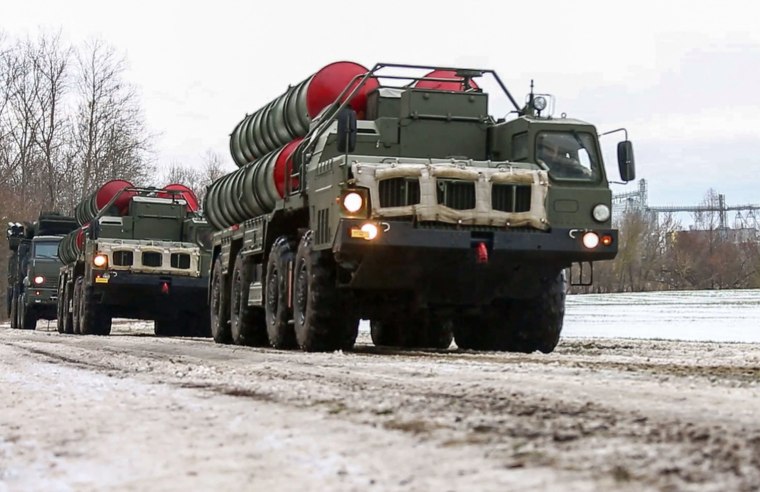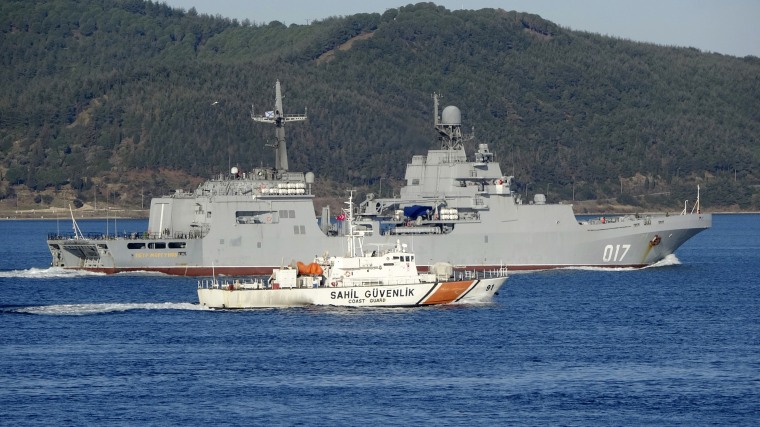Russia began major military drills with close ally Belarus on Thursday, the latest stage in a massive military buildup near Ukraine's borders that has stoked fears Moscow could invade its neighbor.
The joint exercises were expected to involve tens of thousands of troops, weapons systems and other forces that have been massing in Belarus, on Ukraine's northern border, for weeks — overseen by Russia's top military commanders. They also coincide with Russian warships arriving in the Black Sea for naval drills off Ukraine's southern coast, a move that Kyiv labeled part of a "hybrid war."
The massive deployment of force has raised concerns that Moscow could use the military and naval drills as a pretext for preparations to attack Ukraine. The Kremlin's standoff with the United States and its allies has shown no sign of easing despite a flurry of diplomatic activity this week, with Britain saying Thursday that the next few days could be “most dangerous moment” in the monthslong crisis.

This active phase of the drills in Belarus is scheduled to last until Feb. 20 and was planned, according to Moscow. NATO said last week that the drills would involve up to 30,000 combat troops, labeling it “the biggest Russian deployment there since the Cold War.”
Moscow has said the troops will withdraw after the exercises, which it said will rehearse “repelling external aggression,” and denied having any plans to attack Ukraine. But the accumulation of forces in Belarus is just part of an extraordinary military buildup around Ukraine that has left Western leaders scrambling to avoid a fresh conflict on European soil.
The White House, which has been sounding the alarm about a possible invasion for weeks, said the drills don’t instill confidence that a de-escalation is possible.
“We see this as certainly more of an escalatory and not a de-escalatory action,” White House press secretary Jen Psaki told reporters Wednesday.
The deputy U.S. secretary of state, Wendy Sherman, echoed the point in an interview with MSNBC on Thursday, saying the timing of the exercises is “suspicious and alarming, and we are very concerned that President [Vladimir] Putin may make the wrong choice” of invading Ukraine rather than pursuing a diplomatic solution to the crisis.
Moscow has said it has the right to move forces across its territory, or that of an ally, as it sees fit. But on Thursday Ukraine accused Russia of blocking parts of the Black Sea and Sea of Azov to its south “under the pretext of naval drills.”
Kyiv's foreign ministry said the arrival of six warships were part of a “hybrid war” campaign and had made navigation in the area virtually impossible, threatening international trade.
Kremlin spokesman Dmitry Peskov said the Russian naval maneuverers were in strict accordance with international maritime law.
Ukraine was holding its own military drills Thursday that will involve the use of weapons sent by Western allies rushing to shore up Kyiv's defenses.
The country's leaders have sought to play down the threat and said the alarmist rhetoric coming out of Washington might create unnecessary panic.

The Kremlin made a series of bold security demands late last year to halt the expansion of NATO in Eastern Europe and stop Ukraine from ever joining the alliance. They have been deemed nonstarters by the U.S. and its allies, but diplomatic efforts have continued in a bid to deter a potential invasion.
French President Emmanuel Macron visited Putin on Monday as Western leaders embarked on a critical week of diplomacy. The French leader said Putin promised not to escalate the conflict, but there was no clear sign of a breakthrough.
On Thursday, British Prime Minister Boris Johnson gave a stark appraisal of the stakes.
“This is probably the most dangerous moment, I would say, in the course of the next few days, in what is the biggest security crisis that Europe has faced for decades," he said at a news conference with NATO Secretary-General Jens Stoltenberg in Brussels.
His top diplomat, Liz Truss, got a frosty reception from her Russian counterpart after heading to Moscow for talks.
Russian Foreign Minister Sergey Lavrov accused Truss of refusing to listen to his arguments, and said it was like talking to a deaf person, according to Reuters.
Meanwhile, representatives from Ukraine, Russia, Germany and France are meeting in Berlin for the latest round of talks on the unresolved conflict in Eastern Ukraine that dates to 2014.
That's when Moscow annexed Ukraine’s Crimean Peninsula and threw its weight behind a separatist insurgency in Ukraine’s east, a war that has rumbled on since despite a series of shaky cease-fires, costing an estimated 14,000 lives, according to the United Nations.
Amid fears of a fresh Russian invasion, the U.S. has moved 3,000 troops to Eastern Europe and was firming up plans to help evacuate Americans if needed through Poland, a senior defense official and a U.S. official told NBC News on Wednesday.
